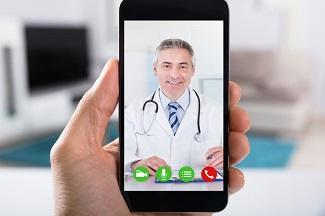Telehealth Wound Care: The Wave of the Future
November 25, 2019
Wound care has evolved into a massive specialty service in the past few decades, with new treatment modalities, advances in care, and thousands of wound care products. On the forefront of advancements in technology and wound care is a new way to provide care to the patient: telehealth. Although we assume that telehealth is a new concept, it actually began around 1906, when William Einthoven experimented with remote electrocardiography consultations over the telephone. The first real-time telehealth consultation would not occur until 1959 at the University of Nebraska.1 Although telehealth in wound care is a fairly new concept, it has expanded in a short period of time. Today there are over 6.5 million patients in the United States who receive wound care via telehealth.2
Is it a Pressure Injury? Factors to Consider When Determining Wound Etiology
How Does Telehealth Work?
The patient receiving care comes to their local facility, and their local nurse will undress and measure the wound. The wound care provider will view the wound with a specialized close-up camera that will show a detailed view of the wound. The provider will also be able to talk to the patient and the caregiver via live secure video and make recommendations and answer questions. The local nurse will redress the wound per recommendations of the provider.3
Benefits of Telehealth in Wound Care
The benefits of telehealth in wound care are extensive and include easier access with reduced travel, reduced costs to the patient and the receiving facility, reduced risks to the patient, and a familiar environment to the patient that reduces anxiety.
Easier access with reduced travel – The patients who benefit the most from telehealth are those who live in rural areas, older adults, and those with illnesses that make it difficult to travel. Some patients living in rural areas may have to travel more than 50 miles to their wound clinic. With telehealth, the patient need travel only to their local facility. It is often difficult for the older adult patient or the chronically ill patient to travel long distances as a result of frailty and other issues. By the time the patient travels long distances for the clinic appointment, they and their caregiver are exhausted. Having telehealth allows less travel, thus leading to less exhaustion.
Reduced costs – Because patients have less distance to travel, the cost to the patient will be less. Some entities, such as the Department of Veterans Affairs, offer travel pay to patients based on mileage. Having the patient travel to their local clinic instead of many miles away to the wound clinic can greatly reduce the costs to the facility. Transporting the patient from a facility such as a long-term care facility requires wages for support staff as well as the costs of a transport agency. If a patient travels to a local clinic, the facility may be able to provide their own transportation or have a family member assist the patient to their appointment.
Reduced risks – Telehealth reduces exposure to and risk of contracting illness. The patient is usually in a smaller clinic and usually spends limited time in the waiting room for their appointment; both factors can decrease exposure to others who are ill. There is a reduced risk of developing and/or worsening pressure injuries because the patient does not have to spend excess time traveling to the appointment.
Familiar environment – Telehealth produces less anxiety for the patient and the caregiver because they do not have to travel as far, and they are coming to a familiar environment with familiar caregivers. Usually these settings are much smaller than the wound care centers, and this also helps reduce anxiety. For the patient with "white-coat syndrome," the telehealth visit can reduce this anxiety because the patient is physically interacting with the nurse providing care and is receiving care in a familiar, more relaxed environment.
Patient satisfaction – A study conducted in Singapore in 2018 not only revealed a high satisfaction rate with telehealth for wound care (98.2%), but also proved a higher rate of healing, mostly because the patient was seen earlier and more frequently.4What Is Needed to Provide Excellent Telehealth Wound Care?
- An excellent camera system with the capability for the provider to view the wound with a specialized close-up camera, with a secure line to ensure HIPAA compliance
- Nursing staff on the patient end with excellent assessment and communication skills because the nurse is the extended eyes, nose, hands, and ears of the provider
- Good documentation skills between the nurse and the provider, both written and verbally
- Proper training of staff and providers on the proper use of telehealth equipment, as well as HIPAA and privacy concerns
Reimbursement
A study conducted in 2015 compared the costs of an average day of hospital inpatient stay, long-term care for one day, and an average home health visit with the cost of one telehealth conference and found phenomenal cost savings with telehealth.4
References
1. Gaydos J. The audio-visual connection: a brief history of telemedicine. Today’s Wound Clin. 2019;13(3):26-29. https://www.todayswoundclinic.com/articles/audio-visual-connection-brie…. Accessed November 24, 2019.
2. Baig M, Gholam Hosseini H, Connolly M. Mobile healthcare applications: system design review, critical issues and challenges. Australas Phys Eng Sci Med. 2015;38(1):23-38. doi: 10.1007/s13246-014-0315-4.
3. Varnado M, Cuzzell J, Cuttino CH, Piette K. Telemedicine solutions for chronic wound management: bridging the gap between wound expert supply & demand. Today’s Wound Clin. 2017;11(5). https://www.todayswoundclinic.com/articles/telemedicine-solutions-chron…. Accessed November 24, 2019.
4. Goh L, Zhu X. Effectiveness of telemedicine for distant wound care advice towards patient outcomes: systematic review and meta-analysis. Int Arch Nurs Health Care. 2017;3(2). doi: 10.23937/2469-5823/1510070.
About the Author
Cathy Wogamon, DNP, MSN, FNP-BC, CWON, CFCN is a Nurse Practitioner at the VA Medical Center in Lake City, Florida. She is the Wound Care Provider in the Out-Patient Clinic serving the Veteran Population of North Florida and South Georgia. Cathy is certified in wound, ostomy and foot care. In addition to her wound care experience, she also has experience in acute care, pediatrics, home health, long-term care and has served as a Professor of Nursing. Cathy’s passion for wound care began while she was working in the long-term care setting as an RN. She serves the veteran population as a memorial to her dad, a combat wounded WWII Veteran.
The views and opinions expressed in this content are solely those of the contributor, and do not represent the views of WoundSource, HMP Global, its affiliates, or subsidiary companies.











